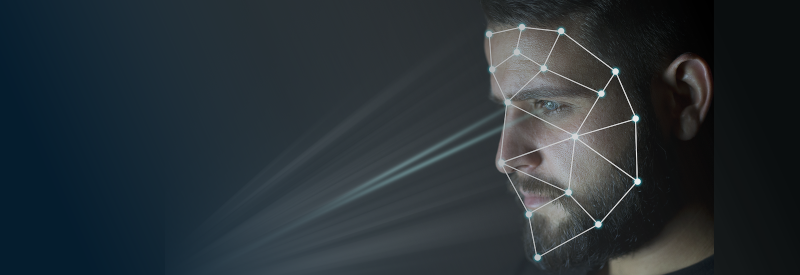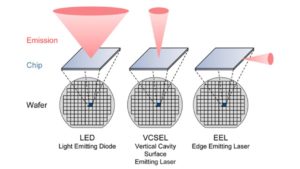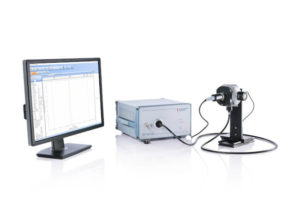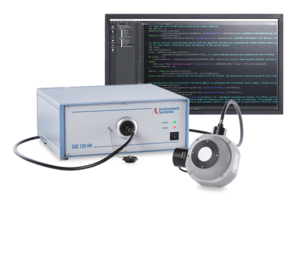Characterization of VCSEL arrays including polarization analysis

Laser diodes are becoming indispensable in a multitude of everyday and industrial applications, thereby expediting new applications and technologies. These include: facial and gesture recognition in consumer electronics, LiDAR (light detection and ranging) in the car and material processing with high-performance diode lasers.
VCSELs are replacing EELs
Laser diodes can be technologically subdivided into EELs (edge-emitting laser) and VCSEL (vertical cavity surface-emitting laser). EELs are edge emitters and emit horizontally to the chip surface. They can be optically characterized only after reflecting surfaces have been attached to the chip edges.
In contrast VCSELs – analogous to LEDs – are surface emitters and emit vertically to the chip surface. The layer structure incorporates the mirror required for the laser cavity. This permits optical characterization of the VCSEL already on the wafer. The VCSEL production process is thus more economical than that of EEL, with the result that they are replacing conventional laser systems in an increasing number of applications. The need for suitable measuring systems for efficient, high-precision optical characterization of these narrow-band light sources is increasing accordingly. As the temporal behavior of laser pulses for many applications is critical, the characterization of the pulse length down to a nanosecond is important.

Exhibit 1.
Schematic comparison of emission direction and spatial radiation properties of LEDs, VCSELs and EELs relative to the wafer or chip surface.
How should VCSEL arrays be measured?
VCSEL single emitter measurement (near field):
The analysis of single emitters is indispensable for the comprehensive characterization of VCSEL arrays. In order to meet the quality standards of VCSEL manufacturers and integrators in the lab and production they must be measured to determine defects, position, polarization, absolute performance and angular range, as well as their single emitter wavelength. Specialized IR cameras are required for the purpose.
VCSEL array measurement (far field):
To guarantee eye safety, the spatial radiation properties of the entire VCSEL arrays must be reliably measured. In the lab this should be done, e.g. with a high-precision goniometer, combined with a high-end spectrometer with traceable calibration. One-shot measurement solutions with a conoscope or transmission screen may be applied in place of the goniometer in production.
Measurement of VCSEL pulses:
Because the temporal behavior of laser pulses is critical for many applications, the characterization of pulse length down to a nanosecond is imperative for VCSEL manufacturers. Suitable measurement systems require excellent spectral resolution, high-performance control electronics and fast photodiodes for power measurement, both in the lab and in production.
Measurement of spectrum and power of VCSEL arrays:
The spectral power of the VCSEL array is measured at special test setups consisting of high-end spectroradiometers and various different integrating sphere configurations. Auxiliary light sources as an extension for self-absorption correction are recommended for greater accuracy.
On the basis of the high-resolution CAS 140CT-HR and CAS 120-HR spectrometers and the new VTC VCSEL test camera Instrument Systems offers modular all-in-one solutions that are optimally tuned to VCSEL characterization (VCSEL production testing, VCSEL measurement).
The challenge: Spectral measurement of laser diodes with a defined error budget and traceability
Measuring systems for laser diodes must satisfy special requirements:
- High spectral resolution
- High throughput volumes in production
- Spectral power measurement of pulsed laser diodes
- 2D analysis of all VCSEL arrays in the near field
- Far-field characterization of VCSEL arrays
Requirements for pulse measurements:
- Very short pulse lengths (≥ 1 ns) at extremely high currents (up to 15A)
- High sampling rates of several gigahertz
- Fast processing of large data volumes for measuring pulse trains
Our solution: Instrument Systems VCSEL test camera and high-resolution spectroradiometer
he CAS 140CT-HR and CAS 120(B)-HR high-resolution array spectroradiometers from Instrument Systems are the flagships of our systems for VCSEL measurement. They enable excellent spectral resolution up to 0.12 nm, and due to short integration times they are ideal for use not only in the lab, but also for extremely high throughput volumes in production.
Instrument Systems has redesigned its VCSEL test camera VTC for the 2D analysis of VCSEL arrays with single emitter analysis. It characterizes defects and position, power and emission data of the individual emitters. In combination with one of our high-resolution CAS spectroradiometers, the VTC camera serves to measure single emitter wavelengths. The addition of a transmission screen will upgrade it to a production capable system for measuring the radiation characteristics of emitters in the far field. One of our far-field goniometers such as the LGS 350 can be used for laboratory analysis.
In Instrument Systems VCSEL test systems the radiant power is determined with an integrating sphere and a spectroradiometer traceably calibrated to PTB or NIST. The VTC camera delivered with flat-field calibration always ensures the highest level of measurement precision.
All-in-one system PVT 110 for the measurement of nanosecond pulses
Instrument Systems developed the PVT 110 specifically for time-resolved measurement of nanosecond pulses. This system has an extremely broad range of applications with the use of different photodiodes for power measurement and characterization of fast pulses, together with fast measurement and analysis of all resulting data flows.
Application Note LIV Testing with SpecWin Pro
Application Note Testing Solutions for VCSELs
Data Sheet OVT 110- Pulsed VCSEL Tester
Data Sheet VTC 4000 Near Field Analysis of VCSEL arrays
Article “In-Line VCSEL Testing”
Click here to Experience our VCSEL portfolio interactively in our video:

Click to view VCSEL Measurement

Click to view VCSEL Production